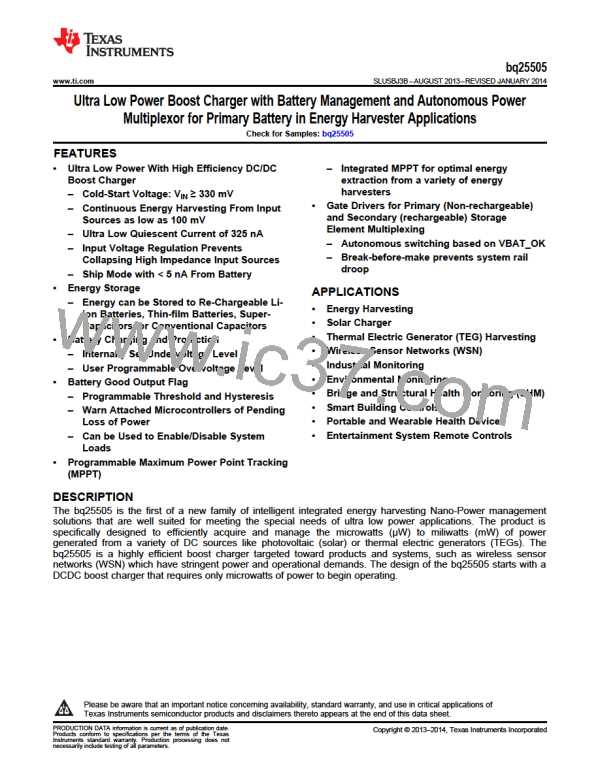bq25505
www.ti.com
SLUSBJ3B –AUGUST 2013–REVISED JANUARY 2014
APPLICATION INFORMATION
Energy Harvester Selection
The energy harvesting source (e.g., solar panel, TEG, vibration element) must provide a minimum level of power
for the IC to operate as designed. The IC's minimum input power required to exit cold start can be estimated as:
PIN > [(I-STR_ELM_LEAK@1.8V X 1.8V) + (1.8V2 / RSTOR(CS))] / 0.05
where I-STR_ELM_LEAK@1.8V is the storage element leakage current at 1.8V and
RSTOR(CS) is the equivalent resitive load on VSTOR during cold start and 0.05 is an estimate of the worst case
efficiency of the cold start circuit.
Once the IC is out of cold start and the system load has been activated (e.g., using the VBAT_OK signal), the
energy harvesting element must provide the main boost charger with at least enough power to meet the average
system load. Assuming RSTOR(AVG) represents the average resistive load on VSTOR, the simplified equation
below gives an estimate of the IC's minimum input power needed during system operation:
PIN X ηEST > PLOAD = (VBAT_OV2 / RSTOR(AVG) + VBAT_OV * I-STR_ELM_LEAK@VBAT_OV
)
where ηEST can be derived from the datasheet efficiency curves for the given input voltage and current and
VBAT_OV. The simplified equation above assumes that, while the harvester is still providing power, the system
goes into low power or sleep mode long enough to charge the storage element so that it can power the system
when the harvester eventually is down. Refer to SLUC463 for a design example that sizes the energy harvester.
Storage Element Selection
In order for the charge management circuitry to protect the storage element from over-charging or discharging,
the storage element must be connected to VBAT pin and the system load tied to the VSTOR pin. Many types of
elements can be used, such as capacitors, super capacitors or various battery chemistries. A storage element
with 100uF equivalent capacitance is required to filter the pulse currents of the PFM switching charger. The
equivalent capacitance of a battery can be computed as computed as:
CEQ = 2 x mAHrBAT(CHRGD) x 3600 s/Hr / VBAT(CHRGD)
In order for the storage element to be able to charge VSTOR capacitor (CSTOR) within the tVB_HOT_PLUG (50 ms
typical) window at hot-plug; therefore preventing the IC from entering cold start, the time constant created by the
storage element's series resistance (plus the resistance of the internal PFET switch) and equivalent capacitance
must be less than tVB_HOT_PLUG . For example, a battery's resistance can be computed as:
RBAT = VBAT / IBAT(CONTINUOUS) from the battery specifications.
The storage element must be sized large enough to provide all of the system load during periods when the
harvester is no longer providing power. The harvester is expected to provide at least enough power to fully
charge the storage element while the system is in low power or sleep mode. Assuming no load on VSTOR (i.e.,
the system is in low power or sleep mode), the following equation estimates charge time from voltage VBAT1 to
VBAT2 for given input power is:
PIN x ηEST X tCHRG = 1/2 X CEQ X (VBAT22 - VBAT12)
Refer to SLUC463 for a design example that sizes the storage element.
Note that if there are large load transients or the storage element has significant impedance then it may be
necessary to increase the CSTOR capacitor from the 4.7uF minimum or add additional capacitance to VBAT in
order to prevent a droop in the VSTOR voltage. See below for guidance on sizing capacitors.
Inductor Selection
The boost charger needs an appropriately sized inductor for proper operation. The inductor's saturation current
should be at least 25% higher than the expected peak inductor currents recommended below if system load
transients on VSTOR are expected. Since this device uses hysteretic control, the boost charger is considered
naturally stable systems (single order transfer function).
Copyright © 2013–2014, Texas Instruments Incorporated
Submit Documentation Feedback
23
Product Folder Links :bq25505

 TI [ TEXAS INSTRUMENTS ]
TI [ TEXAS INSTRUMENTS ]